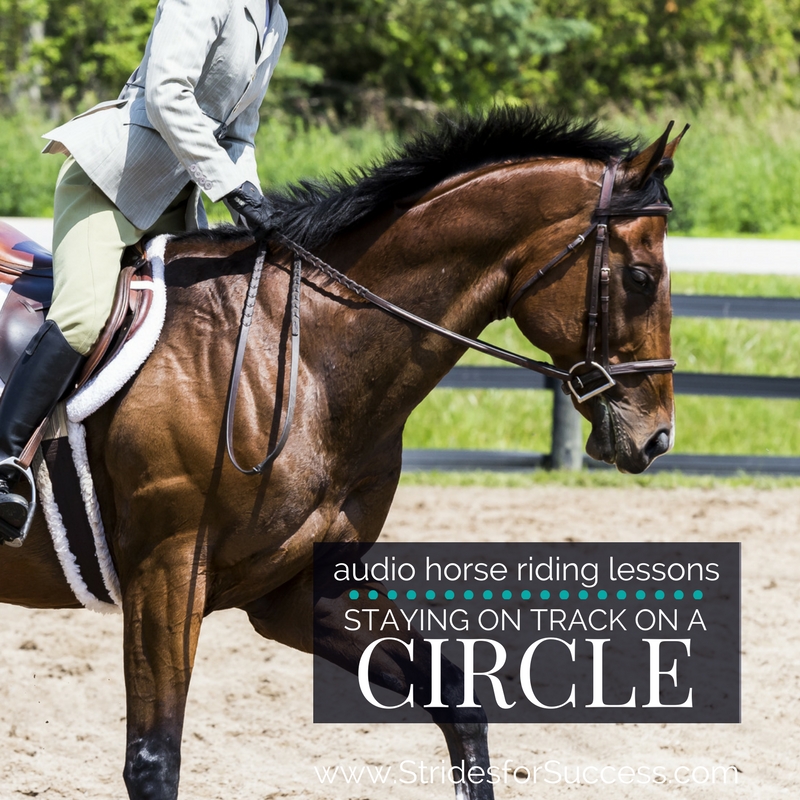
What this episode is all about & how it can help you:-
- What is straightness on a circle
- Creating a channel and maintaining it
- The importance of independent aids to maintain the circle
- What can go wrong and how to identify and work on it
I am willing to bet that every time you get in the arena with your horse, you are riding circles in some ‘shape or form’. Imagine if you became really focused and intentional about those circles and how they are working towards your overall schooling…
Mark Your Circles Out if Necessary
Circles are something we learn from very early, however they are also something that most riders don’t really ride very well. The shape they are riding is not a true circle, it is not very accurate. Before you begin working on riding circles with your horse, first go and mark your circles out.
How many markers you need will depend on your abilities to ride a line.
If you are unsure, rather put more and then take away if necessary. More would look like eight markers, less would look like four markers, but it is entirely up to yourself. What is important is that the bend or arc remains consistent for the whole circle.
Simply put; there should be no straight lines or corners!
What Becoming ‘Off Track’ Looks Like on a Circle
One of the most important concepts when riding a circle is being straight on the circle. It sounds like a contradiction, doesn’t it? However, straightness on a circle simply means that your horses two left legs are on one track and his two right legs are on another track.
It looks a lot like train tracks; your horses two tracks remain parallel to each other regardless of where they go.
If your horse ‘derails’ off of those tracks, you will lose energy and as a result, lose connection and forwardness. Your responsibility is to establish those tracks and then maintaining your horse moving along those tracks.
Creating a Channel using Your Aids
Every time you are in the saddle, whether you are riding a straight line or a circle, you should be thinking about your channel and how you can improve it.
Your channel is how you direct your horse’s energy.
This energy is created in the hind quarters, the backend or engine of your horse, and then funnelled along, through your horses back to the front end, where you can gather it up by creating contact and connection.
When the channel is not maintained, this energy can either leak out or ‘overflow’ in certain areas. As soon as the energy is not going where you want it to go, there is a lack of flow in your horses way of going – and the potential to become ‘derailed’ off of your tracks when you are on a circle!
Your channel is maintained by establishing and then continuously adjusting the balance between all your different aids.
Why Does the Your Horse ‘Derail’?
In a previous episode we spoke about the importance of your independent seat. How, in order for you to truly communicate with your horse effectively, all your aids must remain independent of each other – but at the same time working together towards a common goal.
When your horse ‘derails’ or goes off track from the initial circle you had planned to ride, this is usually due to an imbalance in your aids. Perhaps your inside hand is too heavy, or your outside leg is asleep on the job. It could be due to your being physically tired in the saddle and unable to maintain the channel as you ride the circle. A loss or lack or relaxation is another common fault that shows up for a lot of riders.
Regardless of the cause of your aids becoming out of balance, the result will generally be that your horse moves off the original track and begins to run (walk, trot or canter) on three or even four tracks.
How Can You Begin Fixing This?
You can begin by understanding the aids to ride a circle (I have included a few links to blog posts on this topic below) and the importance of riding each individual stride in order to create a better overall circle.
You can also work on your position. Where are your seat-bones in the saddle? And your legs? Are your hands and shoulders doing what they are supposed to be doing? Are you ‘weighting’ the inside seat-bone correctly? Can you feel both seat-bones on the saddle at all times?
There are a lot of things to think about when riding circles and even more when you begin really seeing circles as an important part of your schooling for your horse.
I am including links below to other trainings on this topic that will help you stay on track with your circles, every single stride.
Links mentioned in the episode:-
Links to other content that will support you in developing your independent seat:-
- Weight Aids and Seat Bones for Turning and Bending
- Asking Your Horse To Bend
- Why is Your horse Falling In?
- Re-schooling a Corner Cutter
- Episode 1017 The Importance of Your Independent Seat
Happy Riding
Lorna
